Day 2 was a bit more traumatic for me as I started the day as I almost always do, going to check the status of the power system. My heart was immediately in my throat as I saw that it was stone cold dead, and would not re-boot.
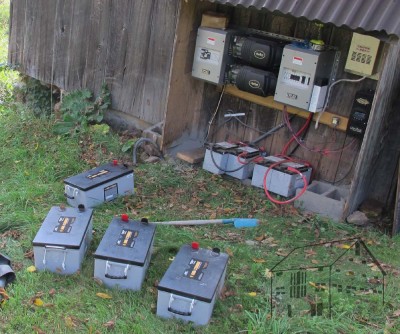
Notwithstanding my battery upgrade last year, when I replaced the four original oversized deep-cycle truck batteries with four OVERSIZED deep cycle batteries, which at 192 pounds apiece were the largest 12-volt batteries available in the US and quadrupled my storage capacity, the system was not operating.

Frantically I consulted with BillR, who has been instrumental in the conception and installation of the system, and he made a “Kentucky windage” guess that the system needed to charge up its reservoir to restart, so all we had to do was wait for the sun and the creek to do their magic.
In the mean time I had four generators ready at the gate, and I fired up my sweet little 3.5kW Suburu generator and made a quick gas run. Unfortunately I missed the beginning of Martin O’Brien’s presentation on color theory and inpainting techniques.
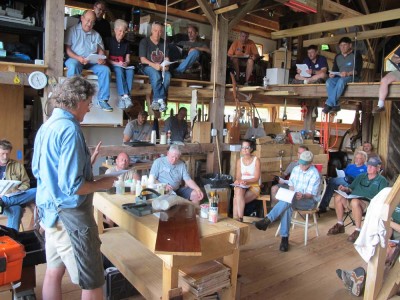
I was checking the system every half hour or so, and at 11:15 it started up. After a lot of head scratching we got it figured out. Apparently during the night someone had started up (or left on) the mondo exhaust fan on the fourth floor and eventually the system shut itself down when the batteries got too low. The fan consumes about 800 watts of juice, and the water turbine output is about 500 watts. Adding the fan juice to the wattage consumed by just the system itself being powered up (200 watts) and the multitude of phones and computers plugged in to recharge, we had no chance in getting through the night unscathed.

After lunch I was on stage presenting Insect Eradication, covering the low-ish-tech methods available to craftsmen facing the problem of powder post beetles or termites in the wood, carpet beetles of other creepy crawlies in the upholstery, or similar troublesome critters.

Covering both aqueous borate salt treatments and anoxic suffocation treatments, the attendees were equipped with the knowledge needed to address this problem. I will be blogging about this topic in late July or August, and will compile those postings into a PDF that you can download as a reference.
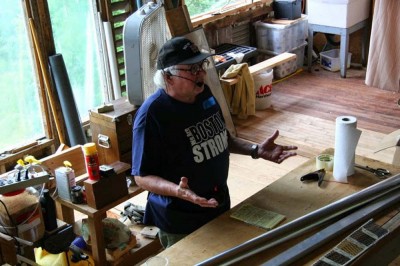
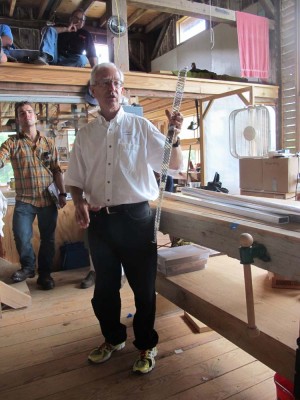
Closing out the afternoon were Bob Judd speaking on the topic of dealing with the mass media on a local scale for obtaining free publicity, and Dan Carlson commenting on a variety of rust-suppressive coatings for metals.

For our evening meal we held our traditional dinner at the Highland Inn’s Black Sheep Tavern, where a grand time was had by all. Heartfelt histories were recited, and many gifts and mementos were presented. More about that later.

Back at the barn at 9PM Joe Amaral began a fascinating presentation first on the repair of a damaged polyester coating, followed by an absolutely captivating discussion of his explorations of oriental lacquer techniques. His own sample boards were a sight to behold, and the crowd stayed strong and attentive until the very end.
After a quick scolding from me regarding the power consumption, I went to bed.
Special thanks again to Joshua Klein for his permission to use many of his photos for this posting.
As the glorious sunrise was fading into broad daylight, the crowd started arriving.. By 9AM we were up in the barn, on the new fourth floor and its wide open meeting space. And holy cow, what a crowd it was. At points in the day, counting spouses and others, we had well over fifty folks on hand.
Fred McLean was our Master of Ceremonies for the week, and Groopstock Coordinator and former Refinisher’s Group forum moderator Ben Myre assembled not only an excellent team to work with him on the planning and execution, but put together a pretty boffo schedule of wide-ranging presentations, demonstrations, and fellowship. 
We began with a brief round of introductions around the room, then quickly moved on to the presentation A Meaningful Life: Thoughts on Life, Craft and Brown & Shiny by Dave Reeves (who also served as Food Coordinator for the week, no small task with this herd of carnivores.) Dave’s talk was universally lauded as a fantastic rumination on the nature of our craft and of life itself. We were all ready to charge out the door to battle in the aftermath.
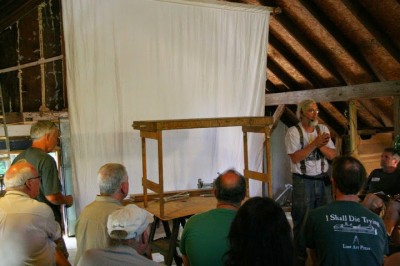
photo courtesy of Joshua Klein
Immediately after that my friend Bill Robillard and I presented an introduction to a folding portable workbench he had commissioned me to make for him. It is a problem I have been working on for many years, having to this point worked my way through three prototype generations.
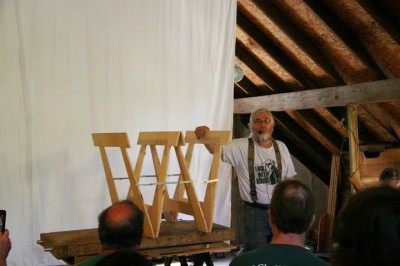
photo courtesy of Joshua Klein
We discussed his needs and our response to these needs, including my “butterfly” which will be covered in the upcoming issue of Popular Woodworking, in preparation for our hands-on fabrication demo on Day 3. I will be blogging about this project at length, and posting a finished and detailed PDF for you to download ex poste. 
Right after lunch Sharon Que talked about fitting new replacement parts during restoration using the technique of “chalk fitting” with both a lecture presentation and a detailed and impressive demonstration down on the main floor. Her skill left us agog, and folks were literally hanging off the balconies.
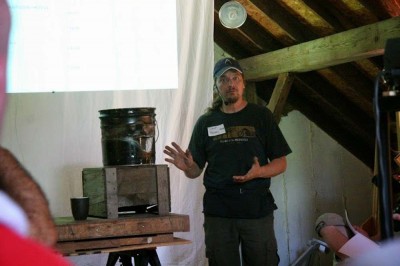
photo courtesy of Joshua Klein
The middle session of the afternoon was by Jon Szalay, “Jersey Jon” from the “Pickers” television show, introducing a topic near and dear to my heart — Foundry 101.
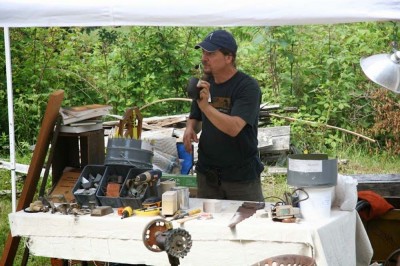
photo courtesy of Joshua Klein
Jon’s presentation took everyone outside to his setup there, and the interest was sky-high.
The afternoon wrapped up with Brian Webster, addressing the needs and strategies for web based marketing. Unfortunately my host duties took me elsewhere on the homestead for these last two presentations, but the conversations were abuzz during dinner so I know they were great.
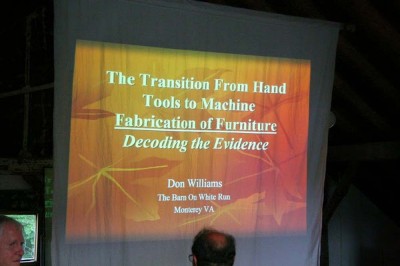
photo courtesy of Joshua Klein
After a fabulous dinner catered by the local Botkin sisters, we reconvened up on the fourth floor for my Powerpoint presentation Transition from Handwork to Machine Made Furniture based in research I did quite a while ago. 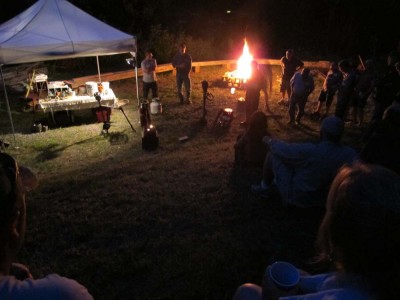
As if that wasn’t enough for one day, the evening lecture was followed by a bonfire and a metal casting demonstration.
Over 16 hours after the day started, I barely remembered tumbling into bed. Those silly folks stayed up gabbing for several more hours.
Last weekend was the maelstrom before the cyclone that is Groopstock, a periodic gathering of members from the Professional Refinisher’s Group. This was the third time we have hosted them at the Barn. For a month I had been readying the homestead, and now was the time to get as much done as possible.
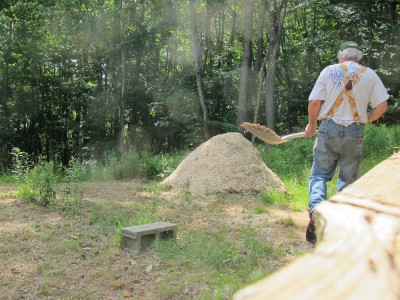
Saturday and Sunday were frantic efforts to finish getting the place clean(er), an endeavor that was not entirely successful. Yes, I got the mountain of planer shavings relocated, and yes I got the meeting spaces more orderly, but I had no time to get my own work space in order and it remained untouched for the week.
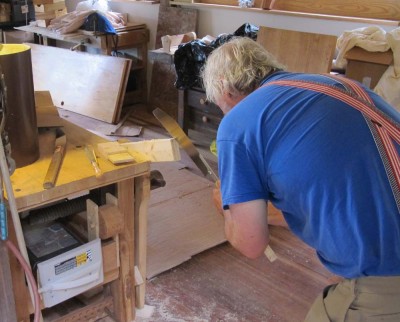
The big accomplishment for the weekend was to build a pair of nine-foot-tall screen doors for the main entrance to the barn, with 1/4″ hardware cloth on the outside and standard window screen on the inside. Thanks to my friend David Blanchard’s mortiser it was a snap.
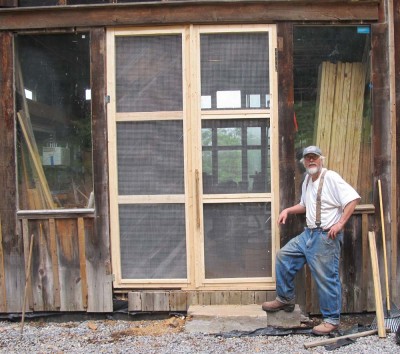
My long time friend and colleague Bruce Hamilton helped get the solid doors moved to the inside of the jamb and swinging in, while the screen doors went where the solid doors were. I have wanted to do this for six years, and now they are done! It provided for excellent ventilation while keeping out the birds I had been shooing out on an hourly basis.
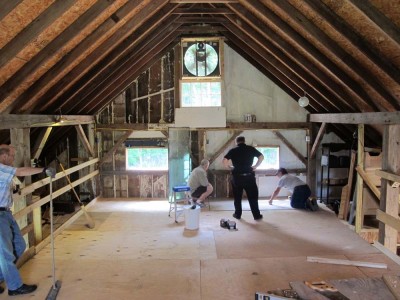
As folks arrived I had little tasks for them, helping with the cleaning and some final floor work and railings for the fourth floor meeting room.
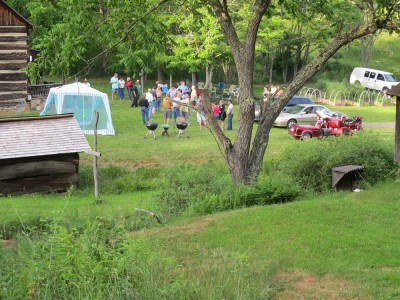
By dinner time they had arrived. By the dozens.
Tomorrow, the report from Day 1.
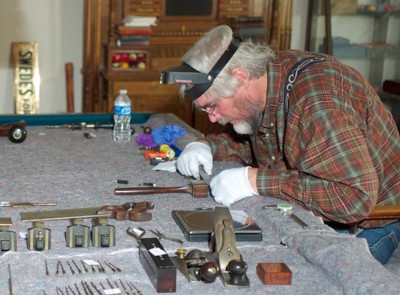
One of the frustrating things about my documentation of Studley’s tools, but still useful in projecting future observations, is the ambiguity about how his tool collection was assembled, and in many cases modified or fabricated. My notes on the subject during the examinations are not glib — they are in fact quite thorough — but neither are they as complete as possible. Or to paraphrase another project, my written and photographic notes, while extensive, are not “as perfectly as possible.” In fact there is no doubt that much about the tools and the man that is un-knowable at this point in time.
These lacunae come into clear focus as I continue writing the manuscript for VIRTUOSO: The Henry O. Studley Tool Cabinet and Workbench. “Yes,” I mutter to myself, “I can see that this was modified, you dope.” My conversations with myself are at best self deprecating. More usually they are caustic and cruel.
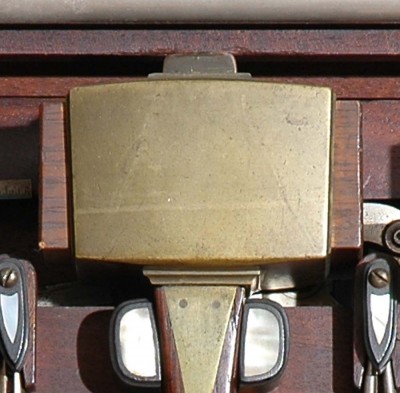
The really good news is that I am compiling an extensive and detailed list of “things to check out” during the final visit, and I have have grafted on a few extra days to work alone, with just a bright light and a microscope to examine everything at a new scale, with new questions.
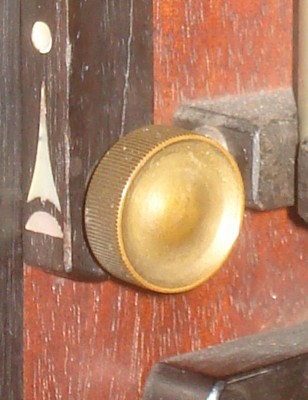
I will spend a lot of time looking microscopic details of things like the moldings along the handle of the mallet along with any further fabrication details (cast? machine from solid stock? brazed from plate stock?), the domed coin-knurled knobs that are everywhere…
While I won’t be able to provide a microscope for you to observe the cabinet or tools in the May 2015 exhibit, I hope to squeeze every bit of information I can out of the collection for you to enjoy along with me.
=================================================
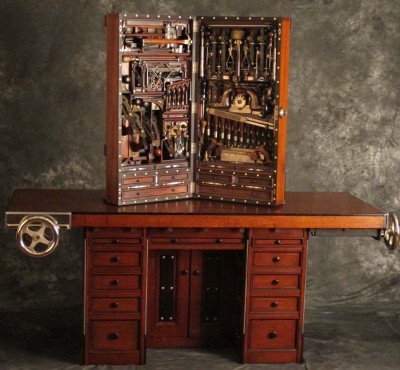
For information about the once-in-a-lifetime three-day-only exhibit of the Studley ensemble, you can find out more here.
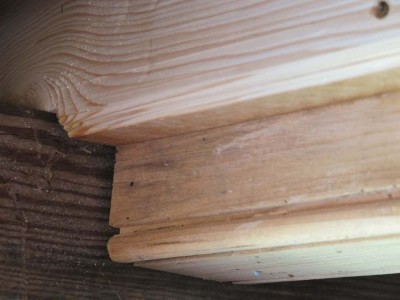
In addition to beefy workbenches, I like robust floors. Floors that “wiggle when you walk” irritate me even if I know they are not unsafe. I like stout floors so much that the main span of the main floor of the barn is constructed with 12″ joists 12″ o.c. with 3/4″ CDX plywood topped with 5/4″ SYP flooring. No motion there.
But the floors for the third floor balconies were a little different story. Those joists were recycled tulip poplar timbers at 24″ o.c. with a double layer of 5/4″ SYP flooring. Given the non-standard nature of the poplar beams, including the fact that some were a little compromised, there was a fair bit of bounce to some of them. Again not unsafe, but bouncy. And irritating.
To compensate for that, given the impending arrival of four dozen folks, about a dozen of whom would be sleeping there, I decided to add some additional strength to selected joists by sistering in some stock. For the most part I used clear-ish 2x4s that I planed down to 5/4; using them full thickness made it look like I was grafting on bratwurst to the timbers, and thinner was a nicer proportion.
So, I spent parts of two days running them through my trusty DeWalt planer, resulting in a mountainous pile of shavings. Following that I put a little Roman ogee on the edge, just because I could.
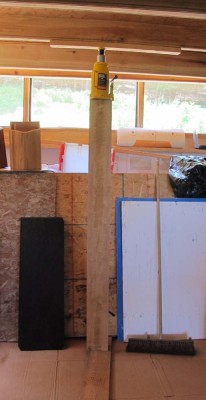
I had already impregnated all the tulip poplar with borate preservative (more about that next week when I blog about the Refinisher’s Group proceedings), so attaching the sisters took some noodling. I could not apply the PVA adhesive to both gluing surfaces since the borate would immediately gel the PVA, so I applied and extra heaping helping of PVA to the new stock, then screwed it is place with 3″ decking screws after crowning the joist a bit with a bottle jack.
The bounce, she is gone.
The vortex that may or may not be appearing in national weather maps just could be the whirlwind emanating from the homestead over the past fortnight and into next week. It all revolves around the task of getting ready for the upcoming gathering of the Professional Refinishers web forum of which I have been a member for many years.
The set-up I normally have for working on and in the barn might be just fine when I am there alone, but it is definitely not fine when fifty people descend on us for a week in paradise. You have no idea how large a four story barn is until you have to get it clean, organized, and safe for such a crowd. That’s pretty much what I have been doing from breakfast until dark every day, and after that comes Mssrs. Roubo and Studley.
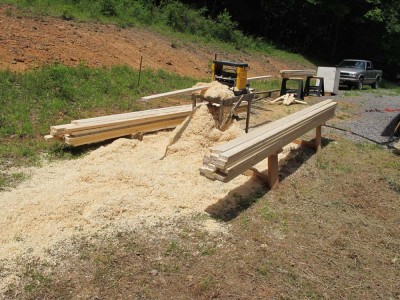
Today was especially busy as I first was wrapping up the cleaning/moving of a huge pile of planer shavings (more about that tomorrow) when I heard a horn honking down in the driveway. It was the delivery of the two portable facilities, an absolute necessity given that the burden of fifty people would far surpass the capacity of our infrastructure. The fellow who delivered them was an absolute gem, as common sense as could ever hope to find.
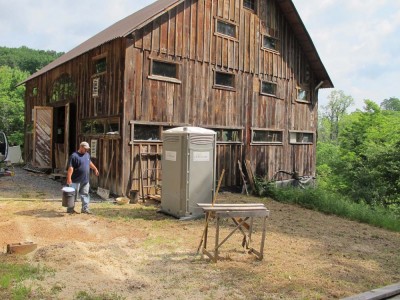
He should be President, but the people would never stand for it. It is clear to me that they prefer grifters and poseurs, or when all the cards are played rightly or wrongly, a grifter who is a poseur.

While the delivery man was up in the barn with me, the the pickup truck bearing the freshly repaired lawn tractor arrived, so now at least we do not have to push a mower around the place.
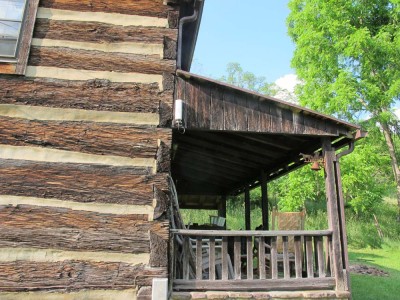
No sooner did that conclude than the two fellows from the phone cooperative arrived to install the wifi extender, to provide for wireless service up in the barn 350 feet from the cabin. They did, and it does. The transmitter unit itself is an unobtrusive box with an integral broadcast antenna, sitting just above the front porch and aimed up at the barn.
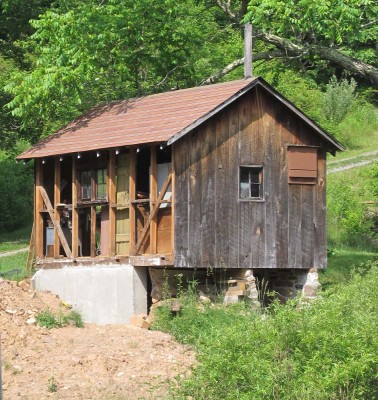
And to conclude the day, the mason dropped by to scope out the final session in restoring the root cellar for the granary, which he will commence tomorrow and finish Saturday, just in time for me to reinstall the vintage chestnut siding just before the arrival of the hordes.
Back to rasslin’ with the string trimmer, knocking down some man-sized weeds.
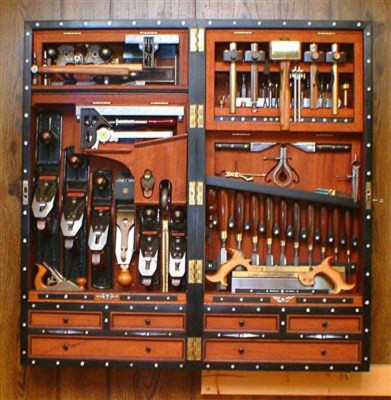
I am at a point in writing the manuscript for VIRTUOSO: The Tool Cabinet and Workbench of Henry O. Studley where I am crafting a section on the woodworking lore and influence of Studley in popular (woodworking) culture, including folks who have interpreted the cabinet and its contents.
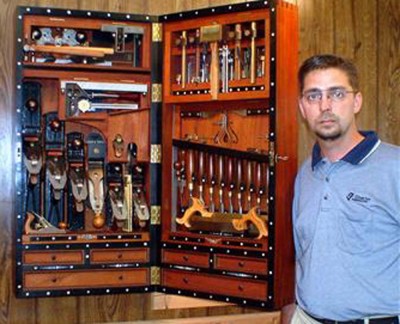
Some time ago I came across this superb effort by Jeff Scott of Alabama. We corresponded once about two years ago, but he seems to have fallen off the map since. I have tried several times to contact him recently to no avail. If you know Jeff, please ask him to contact me or send me the contact info for me to interview him, and perhaps even visit and photograph his tool set and cabinet.
I found these pictures on the web somewhere, so they are the best I can do for know.
============================================
The web site for the upcoming May 2015 exhibit of Studley’s ensemble is here, with tickets available here This is the very first time the cabinet and tools will be on exhibit along with the amazing workbench.
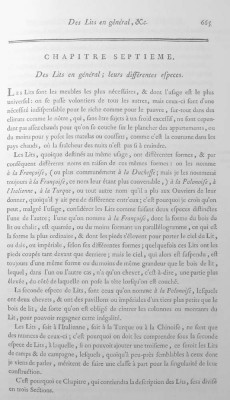
Yesterday as Michele and I were completing the FINAL review of a section of the manuscript (the overwhelming majority of the manuscript is already in the Lost Art Press sausage grinder) we could not help but notice the big hole we had left in the volume To Make As Perfectly As Possible: Roubo On Furniture Making.
Beds.
You see, the whole point of starting the Roubo Project seven years ago was amusement.
Mine.
Not in the sense of what I found humorous, but rather the things I found interesting. If it was not interesting to me, it wasn’t going in the book. And I am not interested in bed making.
This is where the weight of history begins to rest heavily on the shoulders. Was I going to allow my own preference to mis-shape the record we were leaving for Anglophone posterity? And, when does preference represent principle, and when does it represent petulance? Even I could see that without the chapter on beds, Roubo would not be complete. So into the hopper it goes.

We have hit the ground sprinting, and by the time the LAP editorial process gets to this chapter, it should be in their hands so no special delays will encumber them in that regard. Still, the process for a book this massive is a hu-u-u-ge undertaking, and I can never show enough appreciation to Chris for taking a chance on us getting this project to fruition.
Now it is my job to persuade Chris to go along with our craziness.
So, those three of you who are passionate about French beds c.1770, and you know who you are, will get your cup overflowing.
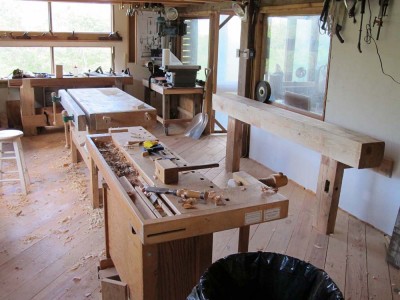
It’s been two years since I installed the 8-foot long southern yellow pine 8″x10″ planing beam in the shop, and it has turned out to be my favorite work station.
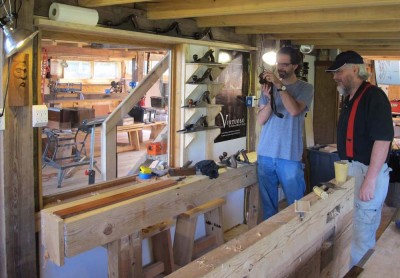
Occasionally an itinerant minstrel stops by to admire it, and if they are reasonably pleasant I even let them give it a test drive.

For the most part it has stayed stable, but this week I noticed a bit of a crown on the top — of course, worst at the business end of the beam! — so I decided to address it forthrightly. The timber itself is eight years old — I bought a stack of green SYP timbers like it when I bought the barn thinking I might need them for repairs, but didn’t — so I expect it will still move a bit for another ten or twelve years.

Flattening the beam is truly a straightforward exercise that made me think of my high school math teacher Mr. Fisk, who was pleasantly rigorous in drilling us with Geometry Postulates and Theorems, and many a time one has popped into my head just when I needed it.
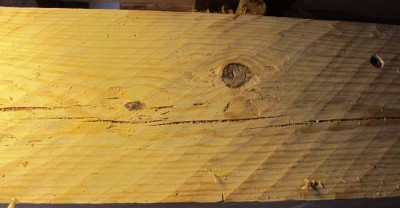
Well, one of the most important of the Postulates for woodworkers is the notion that any two intersecting lines establish a plane. What this means in practice is that if you address any surface with a hand plane, first at 45-degrees to the left, then 45-degrees to the right, when the two patterns meet and cover the entire face you have established a planar surface.

So I did that with a scrub plane, then finished off the surface with a toothing plane to give it a little texture while keeping it flat. At some point I will deal with the front surface, which is now almost certainly not perfectly square to the top. But not this week.
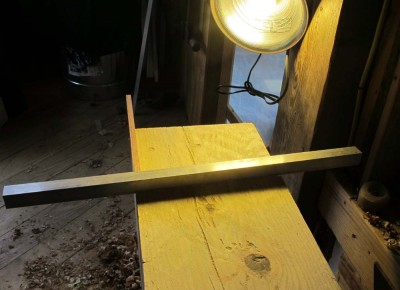
Up next will be getting some help in bringing the 14-foot southern yellow pine 10″x 10″ up from the basement to make a really spectacular planing beam. Maybe next month.
One of the many culture shocks in moving from the Stalinist Peoples’ Republic of Maryland to East Boondocks, Virginia, is the scale of commerce and gubmint. Prince Georges County, Maryland, is a corrupt and crowded place (a previous County Administrator’s wife was caught with her underwear stuffed to overflowing with cash during the sting that sent her and her husband to the Big House) with nearly a million inhabitants, and dealing with the gubmint offices there is a descent into Dante’s Seventh Circle of Hell. Any foray in person to the Motor Vehicle Administration there confirms that Kafka and Orwell were drug addled optimists. I have had instances of where a single simple auto title transfer took two days of vacation time.
Now we live in a county in the Virginia mountains that is so remote and sparsely populated that a full-service Department of Motor Vehicles office — necessary for the change of address and the acquisition of a drivers license — requires a drive of an hour-and-a-half to the facility in Covinington VA. That was the task I assigned to myself for the day.
But, guess what? And here I am uttering words I thought were metaphysically impossible: it was GREAT! The staff was polite and helpful, literally calling out to me as I was still in the entryway. 45 minutes later I departed with a new title for my truck AND the tags AND a new title for my trailer AND the tag AND a new drivers license AND a new voter registration. Just about any one of those would have been a day’s misadventure back in PGCMD.
Surely, the Age of Miracles is not over!














































Recent Comments